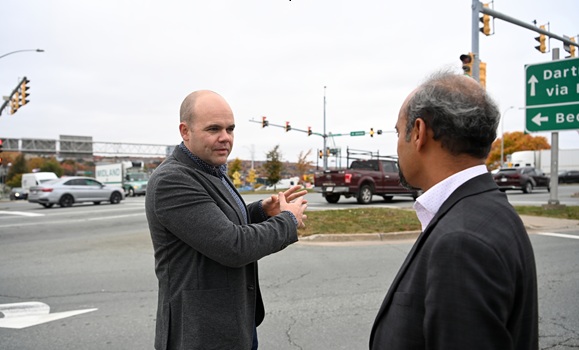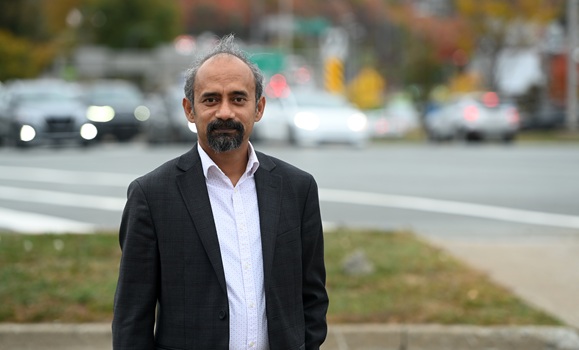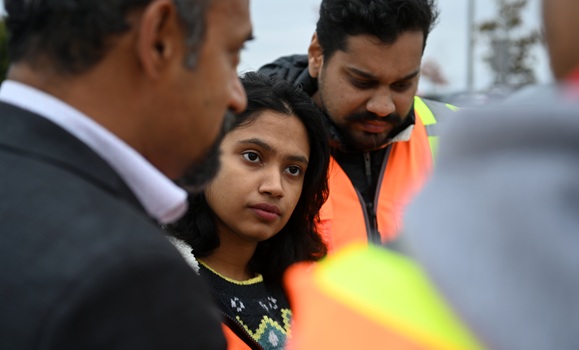THE SNAPSHOT
Dalhousie research is helping the Halifax Regional Municipality plan a transportation system that’s efficient, sustainable, and ready for the city’s rapid growth. By modeling how residents move, commute, and adapt to change, Dalhousie and HRM are shaping data-driven infrastructure that meets today’s needs while preparing for tomorrow.
THE CHALLENGE: A city growing faster than its streets
When Halifax grows, its streets feel the pressure first, and in the past five years, the city has expanded at a surprisingly rapid rate.
“We have been one of the fastest growing cities in the country in recent years,” says Mike Connors, transportation manager with the Halifax Regional Municipality (HRM). “The growth that we’ve seen in the last five years was supposed to take 15 to 20 years. This has put a strain on the city's infrastructure.”
Halifax HRM transportation manager Mike Connors discusses the need to keep traffic moving at Halifax’s Windsor Street Exchange
A long-standing partnership between the Dalhousie Transportation Collaboratory (DalTRAC) and HRM is helping answer a critical question: how do we build transportation systems that serve today’s needs while preparing for tomorrow’s challenges?
THE SOLUTION: Modeling the movement of a city
DalTRAC, led by Dr. Ahsan Habib, professor in Dalhousie’s School of Planning, develops advanced activity-based travel and emissions models that allow the city and its partners to test scenarios before investing in infrastructure changes.
“Our research provides valuable insights into travel behaviour, including working from home and online shopping, and their associated impacts on vehicular emissions,” says Dr. Habib. “The results are already being used for transportation planning in Halifax and Nova Scotia.”
Dr. Ahsan Habib founder of DalTRAC
At the core of this work is data captured through household travel surveys that show how residents move around the city.
“The household travel survey is a foundational piece to our work,” explains Adam Lanigan, Senior Transportation Engineer with HRM. “The surveys ask people key questions about their movement, like Where did you go? What did you do? How did you get there? This allows us to set a baseline behaviour in our model, which helps us predict the future of our infrastructure needs.”
Dr. Habib describes Halifax as the project’s prototype city. “The travel survey and the model we developed here are guiding the process of generating decision-support tools for other Canadian municipalities,” he says. “This is a made-in-Nova-Scotia innovation with national relevance.”
THE WORK: Capturing change in real time
The surveys and models have been especially valuable in capturing the effects of COVID-19 on travel behaviour and how it has rebounded. Remote and hybrid work, for example, emerged as a key factor that wasn’t in earlier models.
Adjusting sensing tool on site to determine output of CO2.
“One bit of data that we pulled from the most recent survey captured shifts in commuting patterns that arose from the pandemic,” says Lanigan. “Now we can model that behaviour and predict changes to it as well.”
Dr. Habib adds that this type of analysis is central to climate planning. “Transportation is one of the largest contributors to greenhouse gas emissions. By understanding new travel patterns, we can help municipalities design climate action strategies that are both ambitious and realistic.”
The DalTRAC–HRM collaboration doesn’t just collect data – it puts it to work. One recent example is the , a major infrastructure investment.
“The model was a key background player,” says Lanigan. “It helped us figure out exactly what we wanted to build, what we expect the area to look like after the work is done, and even how traffic and buses will move during construction.”

Aerial view of Windsor Street Exchange
“The model is critical to the work we do,” adds Connors. “But without the data that goes into the model, the model would be useless.”
As Halifax grows denser, questions about space, equity, and sustainability are unavoidable.
“These are difficult conversations,” says Lanigan. “We can move a lot more people in a lane full of buses than in a lane full of cars. But that requires change, and that’s what’s difficult for a lot of people.”
For Connors, good data is essential in navigating those debates. “Sometimes changes made to streets can make them a little more congested for people driving, but they work more efficiently for buses. We need to be able to demonstrate that with solid evidence.”
“These models give decision-makers options,” agrees Dr. Habib. “We can show council and the public what different futures might look like, and what each means for mobility, emissions, and quality of life.”
THE IMPACT: Data-driven growth for a sustainable city
According to Dr. Habib, this type of applied impact is what makes the project unique. “We don’t just build models and collect data for academic purposes. We build them with our partners, and they are directly embedded into the decision-making processes.
Beyond immediate planning benefits, the collaboration is helping to build local talent in a highly specialized field. Students trained in DalTRAC often move into planning roles with HRM or consulting firms, strengthening the region’s capacity to manage growth.
Dr. Habib meets with students to discuss findings
“There wasn’t really a stream of transportation planning and engineering students before,” says Lanigan. “With a growing city, we need more talent. To have them involved in projects as they get their degrees is really helpful.”
For Dr. Habib, that training component is central. “This is research that lives in the community,” he says. “Our students are not only generating the data, but also using it to learn, to innovate, and to join the workforce in Nova Scotia. It’s a cycle that keeps building local expertise.”
For HRM, Dalhousie, and their many partners, the collaboration lays the groundwork for the region’s future. The data may be complex, but the goal is simple – an infrastructure system that is efficient, sustainable, and responsive to the needs of a growing population.
“This partnership demonstrates how academic research, government collaboration, and community engagement can come together to shape a more sustainable future for Nova Scotia,” says Dr. Habib.
As Connors puts it, “The foundation is important for a house. The data is the foundation for everything we do.”
How it was funded
Dr. Ahsan’s partnership with the Halifax Regional Municipality was supported by an , which fosters collaboration between university researchers and partner organizations in the private, public, or not-for-profit sectors to accelerate the application of research for Canadians’ benefit.
Additional funding came from the Government of Canada’s , which supports Canadian-led projects that reduce greenhouse gas emissions and create science- and technology-based jobs.





